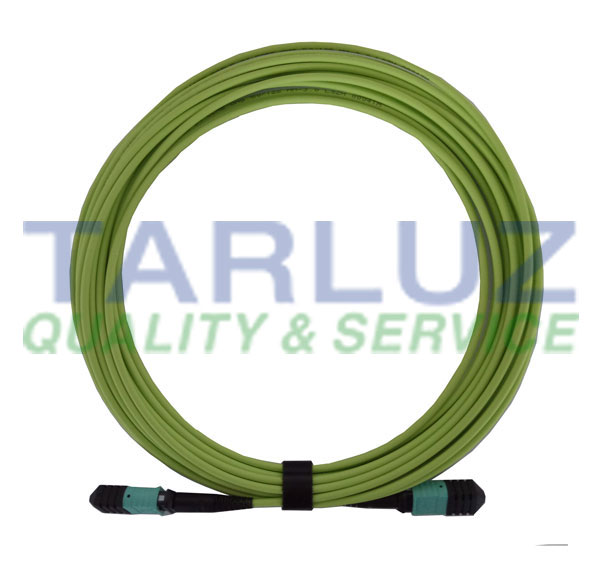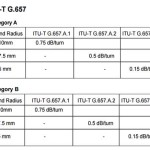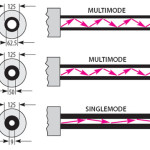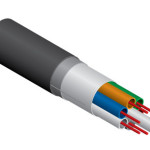Which fiber cable to use? Which value to measure? Which length to get? This fact sheet provides practical answers without devoting to the theoretical background.
Started fiber optic cable for data installations with OM1, now there is already OM5. Started Ethernet over fiber with 100BaseLX, now there are dozens of different protocols. What does the installer need to know?
Which fiber cable to choose?
The choice for Multimode or Single mode fiber depends on the protocol chosen and the distance that can be bridged. With the cheaper cost of single mode equipment compared to the multimode equipment, single mode connections are increasingly being chosen. In this overview we limit ourselves to multimode fiber. This is still the most used connection for indoor buildings / grounds, for switch-switch connections or to cameras, etc.
OM5 is the latest fiber and brings a slight improvement of the distance that can be interconnected compared to OM4. There is a hefty price tag, so it is not always the most logical choice. Most protocols work fine over OM3 or OM4.
There are a number of protocols that work with multiple fibers in parallel, such as “40GBase-SR4” that works with 4 fibers. Such a connection is of course almost twice as expensive as one with two fibers.
In fact, only the very fastest connections with “SWDM” (short wavelength devision multiplexing) require an OM4 or OM5 fiber – for example the protocol “100G SWDM” (100 Gibabit over 2 multimode fibers).
A practical overview

The colors of cords and connectors are not 100% standardized. Furthermore, for example, a loose-tube cable has no color code for the type of fiber. Then one must rely on the printing on the mantle.
The loss of the cable is of course a fact of the manufacturer, but the loss of the total connection depends on the installation. The latest connections operate on a number of different wavelengths at the same time, but the attenuation is only measured at 850nm. As can be calculated from the table, the loss will never only come from the cable, but also from splicing and connector transitions.
Measurements
The loss of the installed connections of multimode fibers therefore only has to take place at 850nm, but with an “encircled flux launch controller”. This is a special measuring cable that ensures that the measurement results are independent of the type of light source; LED or LASER. The bottom line is that with this cord the light is distributed over the core of the fiber. Such a cord looks like a small box with a patch cord on both sides.
Questions and Answers
What do I have to do with figures about the bandwidth of the fibers?
EMB (Effective Modal Bandwidth) is an important characteristic of the different fibers. However, it does not have to be measured during installation. So you can also forget this table immediately;
OM3: 2000 MHz.km
OM4: 4700 MHz.km
OM5: 4700 MHz.km @ 850 nm / 2470 MHz.km @ 953 nm
Your figures of loss or distance are not correct, what do I have to do now?
“The beauty of standards is that there are so many to choose from” someone once said. There are several standardization institutes that use different figures. The above numbers are for installed connections. Other standards concern, for example, the as yet uninstalled components. The distances also depend on the manufacturer of the equipment; one device will be able to bridge a greater distance than the other. So these are “rules of thumb”.
Can I mix fibers together, for example an OM5 pigtail on an OM3 cable?
The fiber types are “downwards compatible” with regard to OM2 to OM5. The OM1 fiber can not be combined with any other. In fact, an OM4 cable with OM3 pigtails will most likely function on both sides for a 40G-SWDM connection, for example. This is because many limiting phenomena (such as 4-wave mixing, dispersion loss, etc.) occur over a larger length and not over a meter’s pigtail.
SWDM works on a different wavelength, do not I have to measure it? and what about 1300 nm?
That’s right; SWDM-4 operates on four different colors of light between 850 and 950 nanometers. It is quite possible that protocols will come up that work on even more colors / wavelengths. It is assumed, however, that when a fiber specified as “OM4” is measured at 850 nm and works well, it also goes well at the other wavelengths. the longer wavelengths (1300 nm) are not used with these fast protocols.
TARLUZ is ready to ship MPO OM5 Patch cord, MTP OM5 Patch Cord, OM5 LC Duplex Patch Cord, etc.
This Ariticle source from Jan Klamer, Business Development Manager of seba service nv. Thanks for his spirit of knowledge sharing.









